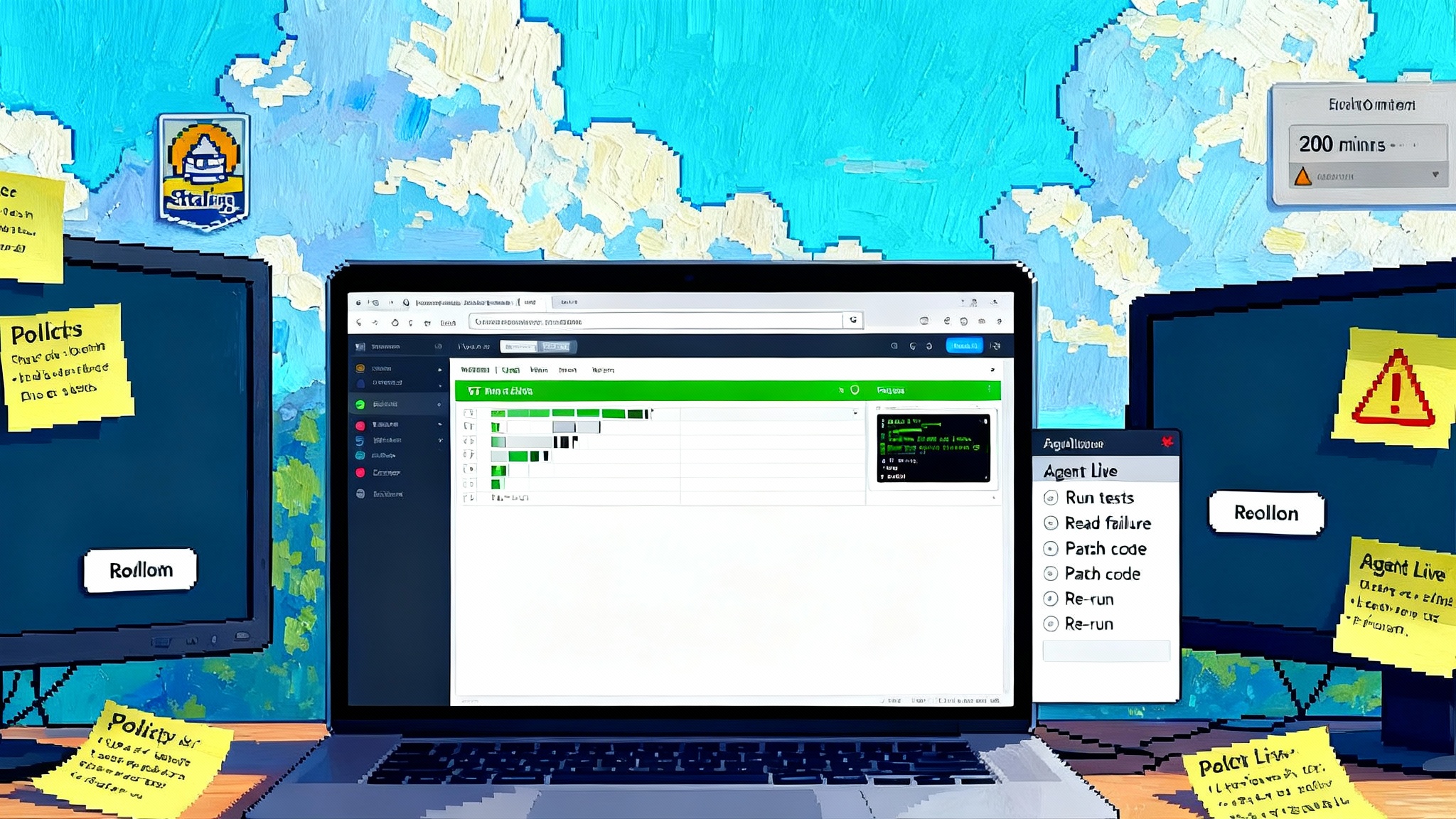Codi’s AI office manager and the rise of self-running offices
On October 21, 2025, Codi unveiled what it calls the first AI office manager, a system that coordinates vendors, restocks pantries, and schedules cleaning. Here is how agentic software is stepping into real-world operations.

Breaking: the first AI office manager grabs the keys
On October 21, 2025, Codi announced what it calls the first artificial intelligence office manager, a platform designed to run the day-to-day operations of a physical workplace. For the last two years, most agentic systems were confined to screens, booking meetings, drafting emails, and moving data between software tools. Codi’s pitch is bolder. It claims to orchestrate real people and real services in real buildings. That means coordinating vendors, restocking pantries, scheduling cleaning, and handling facilities work without a human office manager in the loop. The company told TechCrunch that it began beta testing in May and officially launched on October 21, alongside early traction numbers reported in the TechCrunch coverage of Codi.
Moving from automating keyboard tasks to running a building is like graduating from a flight simulator to a regional airline. The stakes are higher, the environment is messy, and the system must interact with people who do not share a common interface or protocol. If it works, the operational tempo starts to look less like a facilities help desk and more like an always-on dispatcher.
What an AI office manager actually does
Think of the office as a living system with three loops: supplies, services, and fixes.
- Supplies: snacks, coffee, printer paper, batteries, whiteboard markers, dishwasher pods.
- Services: cleaning, window washing, plant care, mail handling, scheduled maintenance.
- Fixes: broken chair wheels, flickering lights, a slow internet line, a faulty badge reader.
A human office manager keeps these loops moving. Codi’s platform aims to keep them moving automatically. Here is a day-in-the-life example of how that could look:
- 7:30 a.m. The system reviews badge data and yesterday’s attendance to predict today’s headcount. It compares that with current pantry inventory and creates a restock order sized to avoid waste.
- 8:15 a.m. The agent messages the preferred grocer as well as a backup vendor. It selects the cheaper option that still hits a delivery window before lunch.
- 9:40 a.m. A sink leak is reported in the team chat with a photo. The agent opens a ticket, checks warranty records, contacts the building’s preferred plumber, and schedules a visit for 11:00 a.m. It posts the estimated arrival time in the facilities channel and updates a log.
- 11:05 a.m. The cleaner reports that two bathroom dispensers are damaged. The agent orders replacements using the approved procurement account and updates the building engineer’s queue for installation tomorrow.
- 2:20 p.m. Occupancy surges due to a customer event. The agent pulls forward a midweek cleaning slot to tonight, notifies security, and requests a later trash pickup so bins do not overflow.
Notice that none of these steps require the bot to invent new policy. They require the bot to interpret status, match it to rules, and act through real vendors. The mechanics sound simple. The execution depends on data quality, integrations, and guardrails.
Why this is happening now
Two trends converged. First, companies returned to the office in fits and starts, exposing the high administrative costs of running spaces with variable attendance. Second, agentic automation matured from prompt-driven assistants to goal-driven systems that can watch, decide, and act across multiple channels. In practical terms, this means an agent can read a calendar, parse a photo of an overflowing bin, check a service contract, send three emails, and file a purchase order in one flow, then prove what it did.
We have watched similar steps in other domains. Legal tech is evolving from copilots to execution layers, as seen when Harvey debuts the agent fabric. Finance operations are adopting autonomy too, with agents for payables at Ramp showing how policy and proof can live together. Office operations are a natural next chapter because the work is repetitive, policy-heavy, and measurable.
Early signals on return on investment
In its launch materials, Codi points to signals that matter to a busy operations lead: hours returned to the team, reduction in administrative spending, and proof of execution. It cites cost reductions of up to eighty three percent for office management overhead and confirms one hundred thousand dollars in annual recurring revenue within five weeks of beta. It also lists early adopters such as TaskRabbit and Northbeam. Those are strong claims, and they put numbers on benefits that buyers can evaluate. For the specifics and the language the company used, see Codi’s October 21 press release.
If you are evaluating this category, ask for three things during a pilot:
- A baseline. Have the vendor measure current ticket closure times, spend per category, and the number of vendor touches per week for four weeks.
- A clean A and B test. Turn the agent on for one office zone, leave a similar zone manual, and compare results over thirty to forty five days.
- A proof bundle. Require a readable log of each action the agent took, the policy that allowed it, the cost it incurred, and any exceptions.
Even if the exact percentage savings vary by building and company size, these steps make the value legible.
The real stack behind a self-running space
Marketing copy can suggest the platform is magic. It is not. The credible version of an AI office manager sits on a pragmatic stack. Here is what that stack looks like and why each layer matters.
- Identity and permissions
- Role based access: define who can approve what, with budget caps by category. A vendor can see work orders but not payroll. A junior coordinator can order supplies up to a limit. The agent itself has a service role that can be restricted by time of day and amount.
- Delegation rules: make approvals time bound. For example, if the primary approver is out after 6:00 p.m., the agent can auto escalate to a secondary.
- Vendor graph and procurement
- Catalogs and rate cards: load preferred vendors, service level agreements, blackout dates, and unit prices. The agent cannot negotiate effectively without a rate card.
- Procurement integrations: connect to the company’s purchasing tools so the agent can create purchase orders, match invoices to receipts, and push payments through a controlled system. In practice, buyers will expect connectors to their accounting suite, their corporate card, and any procurement marketplace they already use.
- Observability and audit
- Unified timeline: every agent action needs a timestamp, the triggering signal, the policy it matched, and the human or system it notified. This is the backbone that keeps security and finance teams comfortable.
- Replay and simulation: operators should be able to replay a workday and see what the agent would have done under different policies or budgets. This builds trust and helps tune behavior.
- Data plane for the physical world
- Sensors and signals: badge swipes, printer status, network monitors, fridge temperature, and simple inventory scans. High fidelity inputs let the agent act before a complaint arrives.
- Human inputs and photos: the most versatile sensor in any building is still a person with a phone. Make it easy to send a photo or a short voice note. The agent should parse both.
- Communication channels
- Email, text, and vendor portals: the agent must speak the language vendors already use. Many do not have a modern application programming interface. Graceful fallbacks are the difference between a demo and a durable system.
- Policy engine and budgeting
- Rules as code: express policies in a human readable format that can be versioned. For example, “restock sparkling water when fewer than three flats remain, but do not exceed two per week without a human ping.”
- Budget guardrails: attach monthly caps by category, with alerts at fifty, eighty, and one hundred percent thresholds.
The lesson is simple. Autonomy that touches money and people must be observable, auditable, and reversible.
What to ask before you switch on autonomy
If you are a head of operations, facilities manager, or finance partner, treat an AI office manager like a new assistant who can place orders and schedule contractors. You would not hand over the company credit card without rules. Apply the same discipline here.
- Start with a narrow slice. Choose one floor or one office with predictable usage.
- Set spending limits by category and time. Allow higher limits during move in weeks. Tighten them during quiet months.
- Require dual control for sensitive functions. Anything that touches network, safety, or access control should require two approvals.
- Use vendor sandboxes. Send the agent to test vendors first. Only then promote to preferred vendors.
- Keep an exception queue. The agent should route edge cases to a human coordinator within minutes, not hours.
- Insist on a weekly audit review. Pull five random actions, read the logs together, and tune the policy.
These steps keep risk predictable while you learn where the agent delivers disproportionate value.
The broader arc: agents escape the browser
For the last few years, many businesses used agents to move information between applications. That work created value, but it did not touch the stubborn operational gaps that drain time. Buildings are full of those gaps. A supply delivery is late. A cleaner calls in sick. Half the team shows up on a Thursday and the bins overflow. Each is small, but they compound.
Bringing an agent into the physical loop means the software must be confident enough to act and humble enough to show its work. The most useful metaphor is air traffic control for the workplace. Planes are people and vendors. Gates are loading docks, loading areas, and floors. The agent does not fly the aircraft. It manages the choreography and clears conflicts before they become delays. The same shift is happening in software, where agentic browsers shift power from passive tabs to active agents that execute user goals.
Where the category expands next
The launch makes sense as a single office tool. The next frontier is scale.
- Multi building portfolios. A regional operator wants one policy engine across a dozen addresses. The agent should smooth spend by shifting deliveries, consolidating orders, and balancing cleaner schedules across sites.
- Warehouses. Inventory and maintenance have more structured data and clearer service windows. An agent can throttle restocks to dock schedules, predict when consumables run low by shift, and pre book forklift maintenance.
- Retail. Store managers juggle merchandising, deliveries, and cleaning. An agent can watch footfall, tie it to stockouts, and shift labor to peak hours.
- Campuses. Universities and corporate campuses are small cities. A campus agent could coordinate grounds, custodial teams, student move in weekends, and event surges with policy based guardrails.
As agents move into these spaces, expect specialization. Some will focus on full service autonomy for small offices. Others will become orchestration layers that sit on top of existing facilities software and procurement tools for large operators. On the developer side, autonomy in code and tooling is accelerating, as projects like Replit Agent 3 makes autonomous coding real demonstrate.
What this changes for startups and for landlords
For startups, the decision calculus is direct. If you have fewer than two hundred employees and no full time facilities team, a credible agent could replace most of the administrative burden for a fraction of one salary. The key is to scope it to repeatable tasks and keep a human in the loop on the edge cases. The payoff is focus. Every hour not spent chasing a cleaner or finding a last minute caterer is an hour spent on product and customers.
For landlords and property managers, the implications are more strategic. A self running layer can make a building feel premium without staffing every floor. If the agent can guarantee service standards and deliver transparent logs, the owner can offer a higher level of service as part of the lease. Over time, that looks like a building operating system that watches occupancy, coordinates services, and reports outcomes to both tenant and owner.
The open questions we should not gloss over
- Vendor coverage. Autonomy is only as good as the vendor network. Coverage gaps will force manual fallbacks. Buyers should demand transparency on vendor density by category and zip code.
- Data rights. Logs about who showed up when, what was ordered, and what failed are sensitive. Contracts must state who owns the data, how long it is retained, and how it is deleted.
- Failure modes. What happens when the agent cannot reach a vendor, a payment fails, or a policy conflicts with a real world constraint like a building that locks loading docks after 6:00 p.m.? Buyers should ask to see a list of known failure modes and how the system degrades gracefully.
- Human roles. When routine tasks are automated, the remaining work skews toward exceptions, events, and culture. Companies must invest in these human centered duties rather than letting them wilt.
These are solvable questions, but they require attention. The value story and the risk story need to be built together.
A simple path to try this in thirty days
Here is a practical plan for a fifty person company to test an AI office manager without betting the farm.
Week 1: baseline and policy
- Measure current weekly spend by category and average time to close facilities tickets.
- Write five starter policies. Examples: restock office snacks twice a week, schedule nightly cleaning on high occupancy days, escalate water leaks immediately, cap monthly pantry spend at a fixed amount, and route all network issues to the building information technology contact first.
Week 2: vendors and approvals
- Load preferred vendors and rate cards.
- Set approval limits. For example, supplies up to a defined amount auto move, anything above that pings a human.
Week 3: limited autonomy
- Turn the agent on for pantry and cleaning only. Keep facilities fixes in read only mode where the agent drafts actions but a human clicks send.
- Review daily logs in a ten minute standup.
Week 4: tighten or widen
- If the logs look clean, allow the agent to schedule basic facilities fixes under a dollar limit. If not, adjust policies and keep learning in draft mode for another week.
- At the end of the month, compare spend, ticket times, and vendor touches with your baseline. Decide whether to expand or pause.
This is the same way operations leaders test any new process. Keep the loop tight, measure, and only then scale.
The bottom line
Codi’s October 21 launch matters because it signals that agentic automation is stepping out of the browser and taking responsibility for the real world. The company has early proof points, clear claims, and recognizable customers. The opportunity is also bigger than one vendor. As offices, retail, property management, and campuses trend toward self running environments, the winners will combine autonomy with transparency. They will show their work. They will accept tight budgets and clear policies. They will make it easy to start small and grow by evidence, not by hype.
When buildings run themselves well, everyone notices the absence of friction. The trash is not overflowing, the pantry is stocked before lunch, the plumber arrives when promised, and the meeting room does not run out of markers at 2:00 p.m. That is not magic. It is software that knows the rules of the house and has the keys to act. We just watched that software step through the door.








